Add listings with multiple seats
Seats handling is included in the default functionality for bookable listings starting from version v6.3.0 of the Sharetribe Web Template
This guide applies exclusively to Sharetribe Web Template versions earlier than v6.0.0 . Version 6.0.0 includes updates to the datepicker component, and this article is based on the previous version of the datepicker.
On our imaginary bike rental marketplace, some listing authors may have several similar bikes to rent. Instead of needing to create separate listings for each similar bike, we can add “seats” to a single listing. This makes it possible for customers to book several similar bikes in one go for the same time period.
In this guide, you will
- Update edit listing availability panel to create listings with
multiple seats
- Add seats handling to default availability form
- Add seats handling to availability exceptions
- Book listings with multiple seats
- Update booking panel for seat selection
- Show input
- Determine correct number of seat options to show
- Update booking breakdown to show seat line items correctly
- Add seats handling to line item calculation
- Update booking panel for seat selection
This guide deals mainly with adding seats for daily bookings. Where the hourly booking implementation differs, you will find collapsible sections describing how and where to make the relevant changes.
Update EditListingAvailabilityPanel to add seats to listings
Seats are a feature of a bookable listing’s availability plan. By default, all listings are created with availability plans featuring one seat.
To enable booking listings with multiple seats, we need to add the ability to create listings whose availability plan contains more than one seat. We will make these changes in EditListingAvailabilityPanel:
- For enabling seats in the default plan, we will update
AvailabilityPlanEntries.js, which is a subcomponent used inEditListingAvailabilityPlanForm.js - For managing seats in availability exceptions, we will update
EditListingAvailabilityExceptionForm.js - For saving both those changes, we will update in
EditListingAvailabilityPanel.js - For showing those changes, we will update in
WeeklyCalendar.js
- EditListingAvailabilityPanel.js
Add seats handling to default availability plan
AvailabilityPlanEntries is a component that, in the
EditListingAvailabilityPlanForm, represents a single day’s
availability.
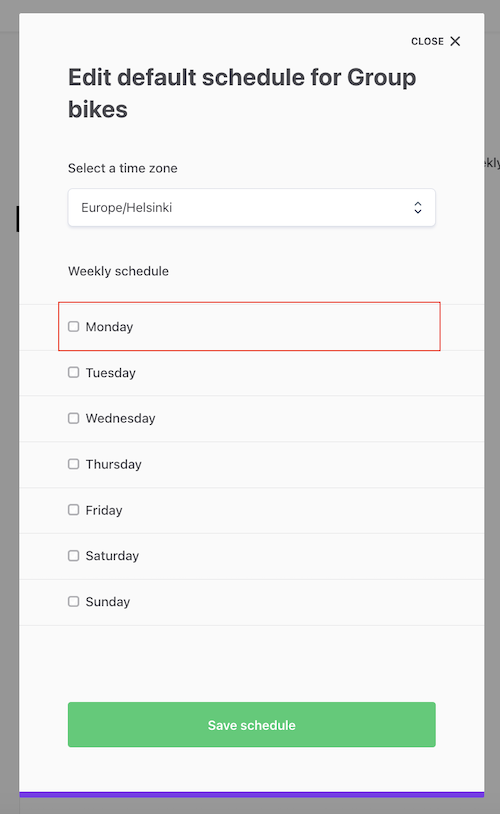
The AvailabilityPlanEntries component handles
- day and night availability (i.e. no time ranges)
- and hourly availability (which does have time ranges).
In this guide, we are using day-based listings.
Show seats input in AvailabilityPlanEntries
We will need to import FieldTextInput from src/components, so let’s
add it to the existing import statement.
import {
InlineTextButton,
IconClose,
FieldSelect,
FieldCheckbox,
FieldTextInput, // add this row
} from '../../../../../components';When the user selects a day as active on a full day listing, the time
range component is hidden by default. Now that we want to allow
modifying seats for each day, however, we can add a seats input to the
hidden time range component.
Replace the existing TimeRangeHidden component with the following
version:
const TimeRangeHidden = (props) => {
const { name, value, onChange, intl } = props;
return (
<div>
<div className={css.formRowHidden}>
<FieldHidden name={`${name}.startTime`} />
<FieldHidden name={`${name}.endTime`} />
</div>
<FieldTextInput
name={`${name}.seats`}
type="number"
initialValue={value.seats}
placeholder={intl.formatMessage({
id: 'EditListingAvailabilityPlanForm.seatsPlaceholder',
})}
min="1"
onChange={onChange}
/>
</div>
);
};The input is numeric, and we define minimum seats as 1, because a day with 0 seats is by default not available.
Next, we want to define the initial seat count when the day is first
selected. That happens in the FieldCheckbox element’s onChange
function. By default, for full days, the form adds an entry to the
results array with start and end times. Let’s expand that entry with
seats, too.
In this section, replace the original formApi.mutators.push statement
with this new one.
<FieldCheckbox
key={checkboxName}
id={checkboxName}
name="activePlanDays"
useSuccessColor
label={intl.formatMessage({
id: `EditListingAvailabilityPlanForm.dayOfWeek.${dayOfWeek}`,
})}
value={dayOfWeek}
onChange={e => {
const isChecked = e.target.checked;
// 'day' and 'night' units use full days
if (useFullDays) {
if (isChecked) {
// /** Replace this: **/
formApi.mutators.push(dayOfWeek, { startTime: '00:00', endTime: '24:00' });
// /** with this: **/
formApi.mutators.push(dayOfWeek, {
startTime: '00:00',
endTime: '24:00',
seats: 1,
});
} else {
formApi.mutators.remove(dayOfWeek, 0);
}Now, we still need to give the correct props to the new
TimeRangeHidden element. In addition to name and key, we pass
value and onChange props, as well as intl.
The value prop passed to TimeRangeHidden is the entry pushed to
formApi.mutators in the checkbox onChange function, i.e.:
{
startTime: '00:00',
endTime: '24:00',
seats: 1,
}In the onChange function, we determine how the current plan gets
updated with the numeric input value.
Replace the existing usage of TimeRangeHidden with the following:
/** Replace this **/
<TimeRangeHidden name={name} key={name} />
/** with this **/
<TimeRangeHidden
name={name}
key={name}
intl={intl}
value={entries[0]}
onChange={e => {
const { value } = e.currentTarget;
const { values } = formApi.getState();
const currentPlan = values[dayOfWeek][0];
formApi.mutators.update(dayOfWeek, 0, { ...currentPlan, seats: value });
}}
/>Add seats for hourly availability
Click here to see how to add seats for hourly availability
If you want to add seats for hourly availability, you can do the
following instead of modifying the TimeRangeHidden component:
- Add a numeric
FieldTextInputto theTimeRangeSelectscomponent:
<FieldTextInput
id={`${name}.seats`}
name={`${name}.seats`}
className={css.fieldSelect}
type="number"
min="1"
/>- Initialise the time range with 1 seat when the daily checkbox is first checked:
} else {
const shouldAddEntry = isChecked && !hasEntries;
if (shouldAddEntry) {
// The 'hour' unit is not initialized with any value,
+ // except seats,
// because user need to pick them themselves.
- formApi.mutators.push(dayOfWeek, { startTime: null, endTime: null });
+ formApi.mutators.push(dayOfWeek, { startTime: null, endTime: null, seats: 1 });
} else if (!isChecked) {
// If day of week checkbox is unchecked,
// we'll remove all the entries for that day.
formApi.mutators.removeBatch(dayOfWeek, entries);
}
}- Initialise the time range with 1 seat when adding a new time range within an existing day:
{!useFullDays && fields.length > 0 ? (
<InlineTextButton
type="button"
className={css.buttonAddNew}
- onClick={() => fields.push({ startTime: null, endTime: null })}
+ onClick={() => fields.push({ startTime: null, endTime: null, seats: 1 })}
>
<FormattedMessage id="EditListingAvailabilityPlanForm.addAnother" />
</InlineTextButton>
) : null}At this point, we can add the marketplace texts necessary in this guide.
You can add the marketplace texts through Sharetribe Console, or in
src/translations/en.js, if you are not using Console-based marketplace
texts.
...
"EditListingAvailabilityPlanForm.seatsPlaceholder": "Select seats...",
"EditListingAvailabilityPanel.WeeklyCalendar.available": "Available ({seats})",
"EditListingAvailabilityExceptionForm.seatsLabel": "Available seats",
"EditListingAvailabilityExceptionForm.seatsPlaceholder": "Select available seats...",
"BookingDatesForm.seatsTitle": "Choose number of seats",
"OrderBreakdown.baseUnitDaySeats": "{unitPrice} x {quantity, number} {quantity, plural, one {day} other {days}} x { seats, number } { seats, plural, one {seat} other {seats} } ",
"OrderBreakdown.baseUnitNightSeats": "{unitPrice} x {quantity, number} {quantity, plural, one {night} other {nights}} x { seats, number } { seats, plural, one {seat} other {seats}}",
"OrderBreakdown.baseUnitHourSeats": "{unitPrice} x {quantity, number} {quantity, plural, one {hour} other {hours}} x { seats, number } { seats, plural, one {seat} other {seats}}",
...Now, we can add seats to selected days, indicating the number of bikes we have available.
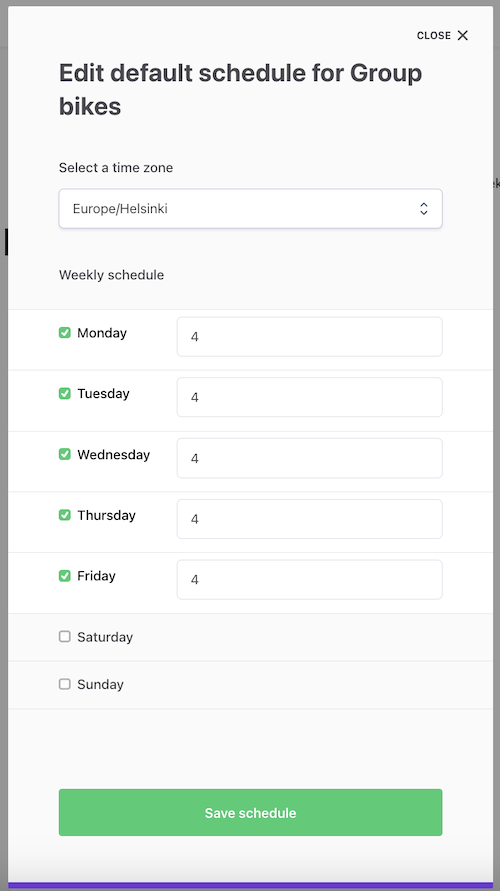
Save seats to default availability plan
When the listing authors clicks “Save schedule” on the default
availability plan modal, EditListingAvailabilityPanel creates
availability plan entries based on the submit values.
- EditListingAvailabilityPanel.js
To do that, it uses a function called createEntriesFromSubmitValues.
// Create entries from submit values
const createEntriesFromSubmitValues = (values) =>
WEEKDAYS.reduce((allEntries, dayOfWeek) => {
const dayValues = values[dayOfWeek] || [];
const dayEntries = dayValues.map((dayValue) => {
const { startTime, endTime } = dayValue;
// Note: This template doesn't support seats yet.
return startTime && endTime
? {
dayOfWeek,
seats: 1,
startTime,
endTime: endTime === '24:00' ? '00:00' : endTime,
}
: null;
});
return allEntries.concat(dayEntries.filter((e) => !!e));
}, []);We want to modify this function to include the seats value coming from
dayValue, instead of using the hard-coded value of 1 seat.
We also add a validation to the seats value – in case the user leaves
the input empty, we pass 0 as seats for that day.
const createEntriesFromSubmitValues = values =>
WEEKDAYS.reduce((allEntries, dayOfWeek) => {
const dayValues = values[dayOfWeek] || [];
const dayEntries = dayValues.map(dayValue => {
- const { startTime, endTime } = dayValue;
+ const { startTime, endTime, seats } = dayValue;
+ const seatsValue = seats ? seats : 0;
// Note: This template doesn't support seats yet.
return startTime && endTime
? {
dayOfWeek,
- seats: 1,
+ seats: seatsValue,
startTime,
endTime: endTime === '24:00' ? '00:00' : endTime,
}
: null;
});
return allEntries.concat(dayEntries.filter(e => !!e));
}, []);Now, the value of the seats input gets saved to the listing’s
availability plan in the listing/update network call.
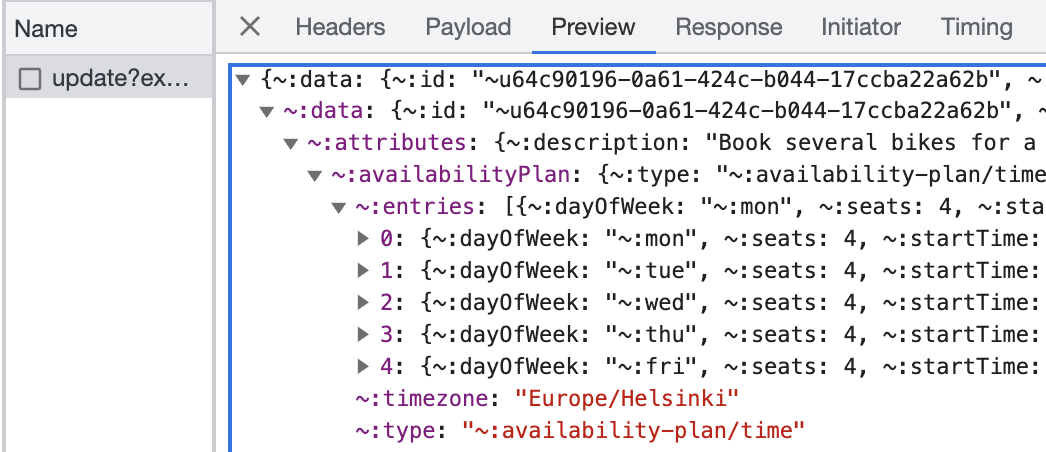
If you now refresh the page and re-open the modal, the seats values we
just saved do not show up in the modal. We still need to update one
function in EditListingAvailabilityPanel.js: createEntryDayGroups.
The createEntryDayGroups function takes the existing availability plan
and maps the existing availability entries into initial values for the
EditListingAvailabilityPlanForm. By default, it does not handle seats,
so we will add seats handling.
// Create initial entry mapping for form's initial values
const createEntryDayGroups = (entries = {}) => {
// Collect info about which days are active in the availability plan form:
let activePlanDays = [];
return entries.reduce((groupedEntries, entry) => {
- const { startTime, endTime: endHour, dayOfWeek } = entry;
+ const { startTime, endTime: endHour, seats, dayOfWeek } = entry;
const dayGroup = groupedEntries[dayOfWeek] || [];
activePlanDays = activePlanDays.includes(dayOfWeek)
? activePlanDays
: [...activePlanDays, dayOfWeek];
return {
...groupedEntries,
[dayOfWeek]: [
...dayGroup,
{
startTime,
endTime: endHour === '00:00' ? '24:00' : endHour,
+ seats,
},
],
activePlanDays,
};
}, {});
};Now the saved values also show up after refreshing the page.
Show default seats in the weekly calendar
As the final step of adding seats to the default availability plan, let’s show the number of available seats in the weekly calendar.
We have already added a marketplace text string that takes a seats
parameter. Now we will pass the seats value to the message.
Similarly to the inputs, the weekly calendar also has an element that
renders a single availability plan entry, called PlanEntry. For full
days, the component shows a formatted message depending on whether the
entry has any seats.
// Component that renders an entry in the availability plan (weekly schedule)
const PlanEntry = ({ date, entry, useFullDays, isDaily, timeZone, intl, ...rest }) => {
const isAvailable = entry.seats > 0;
const availabilityInfo = isAvailable ? (
<FormattedMessage id="EditListingAvailabilityPanel.WeeklyCalendar.available" />
) : (
<FormattedMessage id="EditListingAvailabilityPanel.WeeklyCalendar.notAvailable" />
);
return (
<div className={css.planEntry} {...rest}>
<div
className={classNames(css.availabilityDot, {
[css.isAvailable]: entry.seats > 0,
})}
/>
{useFullDays ? (
availabilityInfo
) : (
...When the entry has seats, we want to pass the seat count to the
FormattedMessage component to be displayed, and we can do it by
passing a value prop.
const isAvailable = entry.seats > 0;
const availabilityInfo = isAvailable ? (
- <FormattedMessage id="EditListingAvailabilityPanel.WeeklyCalendar.available" />
+ <FormattedMessage
+ id="EditListingAvailabilityPanel.WeeklyCalendar.available"
+ values={{ seats: entry.seats }}
+ />
) : (
<FormattedMessage id="EditListingAvailabilityPanel.WeeklyCalendar.notAvailable" />
);Now, the weekly calendar shows the default seats available for each entry.
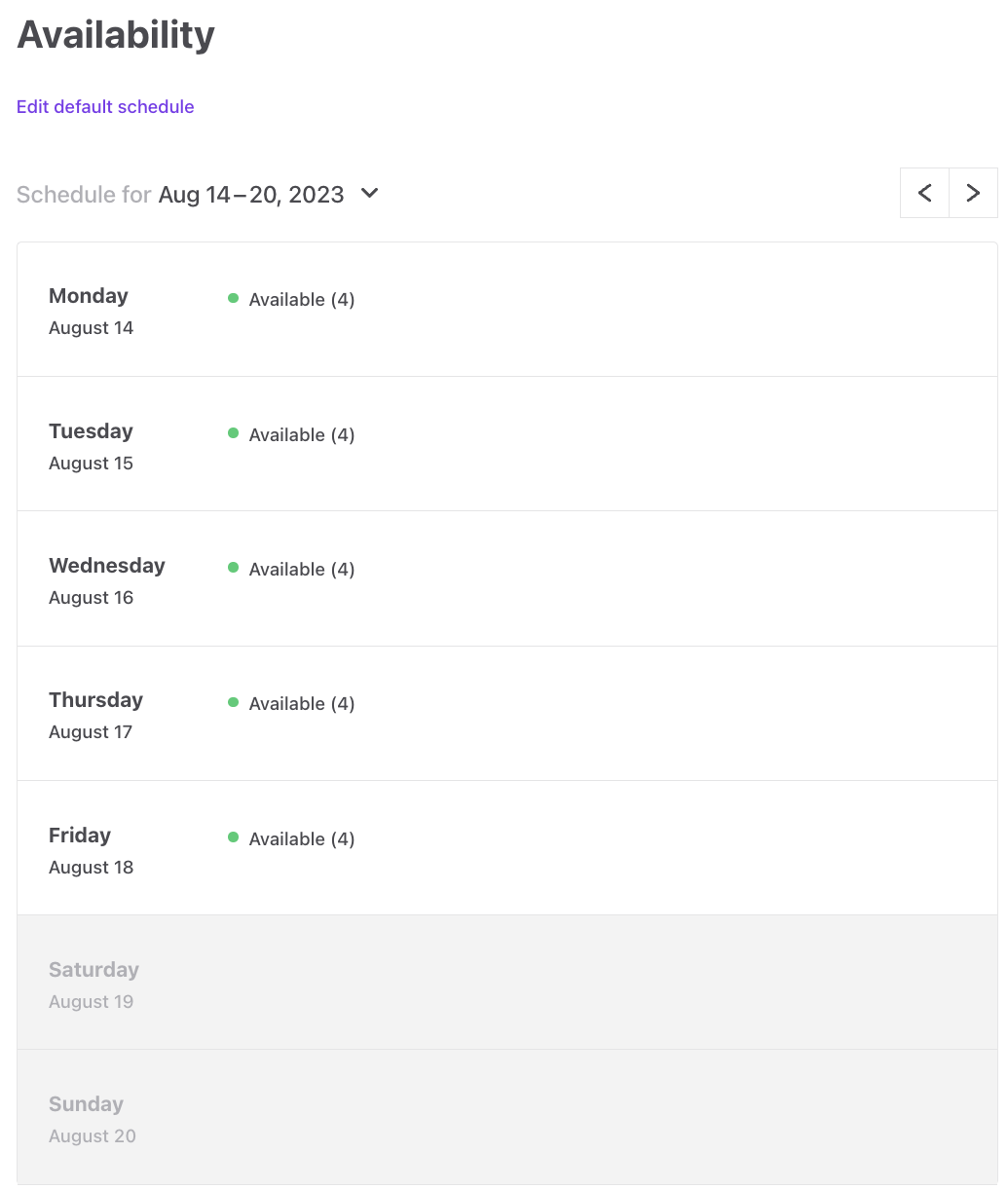
Show seats for hourly availability
Click here to see how to show seats for hourly availability
If you are working with hourly bookings, you can do the following
instead of modifying the availabilityInfo message:
- Pass the
entry.seatsvalue as a new prop fromWeeklyCalendar.PlanEntrytoTimeRange
return (
<div className={css.planEntry} {...rest}>
<div
className={classNames(css.availabilityDot, {
[css.isAvailable]: entry.seats > 0,
})}
/>
{useFullDays ? (
availabilityInfo
) : (
<TimeRange
className={css.timeRange}
startDate={parseLocalizedTime(date, entry.startTime, timeZone)}
endDate={getEndTimeAsDate(date, entry.endTime, isDaily, timeZone)}
+ seats={entry.seats}
dateType={useFullDays ? DATE_TYPE_DATE : DATE_TYPE_TIME}
timeZone={timeZone}
/>
)}
</div>
);- In
TimeRange, get theseatsvalue from props.
export const TimeRangeComponent = props => {
const { rootClassName, className, startDate, endDate, seats, dateType, timeZone, intl } = props;
const start = formatDateIntoPartials(startDate, intl, { timeZone });
...- Show the
seatsprop in thespanelements withclassName={css.dateSection}inTimeRange, e.g.
...
} else if (isSingleDay && dateType === DATE_TYPE_DATETIME) {
return (
<div className={classes}>
<span className={css.dateSection}>{`${start.date}, ${start.time} - ${end.time}`} ({seats})</span>
</div>
);
} else {
return (
<div className={classes}>
<span className={css.dateSection}>{`${start.dateAndTime} - `}</span>
<span className={css.dateSection}>{`${end.dateAndTime}`} ({seats})</span>
</div>
);
}Next, let’s enable seat handling in availability exceptions.
Add seats handling to EditListingAvailabilityExceptionForm
In addition to the default listing availability plan, we want to allow users to set seats for availability exceptions.
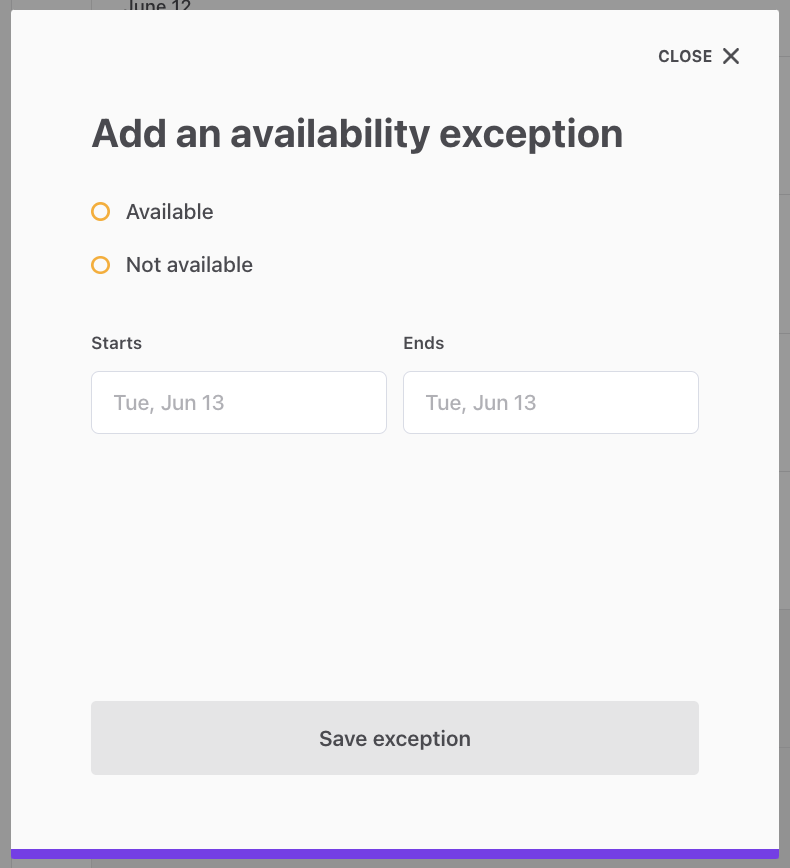
The default behavior of the availability exception form is that for non-available time slots, seats are set as 0, and for available time slots, seats are set as 1. We want to allow users to create exceptions with multiple seats.
Creating exceptions with multiple seats is a great way to manage event-based marketplaces.
By removing all default plan entries, you can set the default plan to always be created with 0 seats. Listing authors can then add availability exceptions with a number of seats to open certain events to bookings.
This way, a service provider can use a single listing to organize multiple rounds of a workshop, or a concert venue can host a series of concerts, with a variable number of seats each time.
First, we’ll again import the FieldTextInput component for seats.
import {
FieldTextInput, // add this row
Form,
H3,
PrimaryButton,
} from '../../../../../components';We only want to show the seat selection input if the listing author has
selected that the exception does have availability. We can check that
value from formState in FinalForm’s render function, and then show
an input component if the value is available.
const formState = formApi.getState();
const isAvailable = formState.values.availability === 'available';
const seatsSelectionMaybe = isAvailable ? (
<FieldTextInput
className={css.seats}
id="seats"
name="seats"
type="number"
min="1"
label={intl.formatMessage({
id: 'EditListingAvailabilityExceptionForm.seatsLabel',
})}
placeholder={intl.formatMessage({
id: 'EditListingAvailabilityExceptionForm.seatsPlaceholder',
})}
/>
) : null;The component uses a CSS class to add a bit of margin, and we need to
add the class to EditListingAvailabilityExceptionForm.module.css.
.seats {
margin-top: 24px;
}Then, we need to include the component in the form.
…
timeZone={timeZone}
values={values}
/>
)}
+ {seatsSelectionMaybe}
</div>
<div className={css.submitButton}>
…Now, we can see the seats input in the availability exception modal.
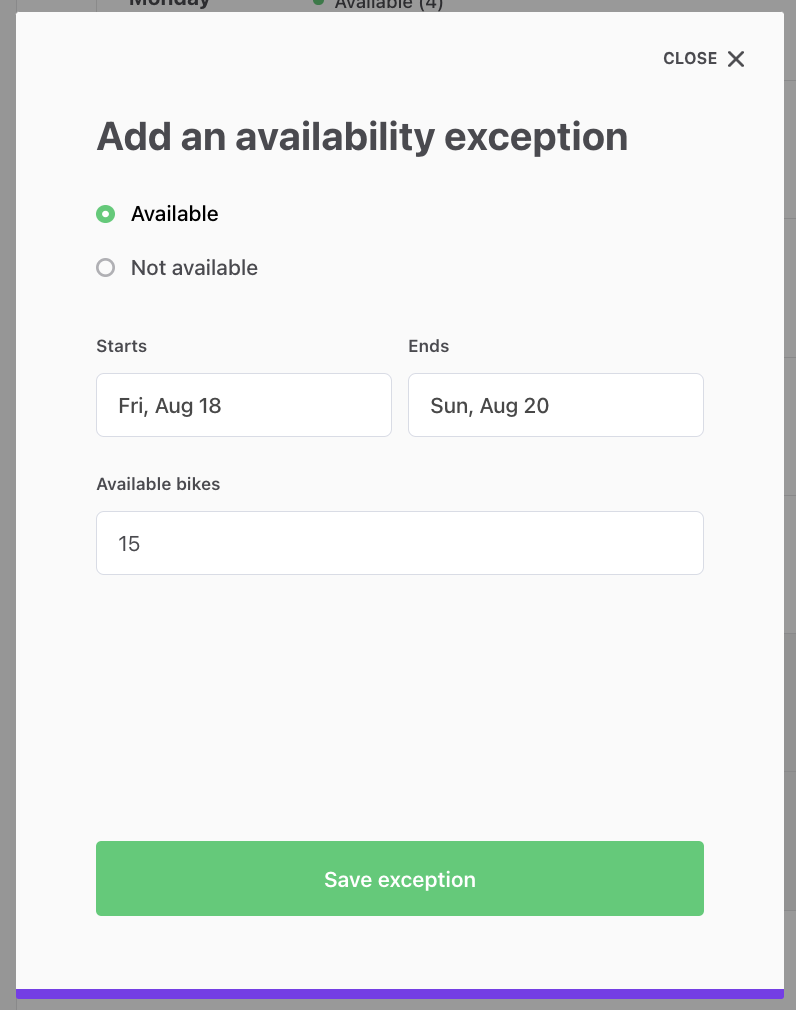
Now, let’s modify the EditListingAvailabilityPanel.js file again to
save the seats we entered. The saving happens in the saveException
function.
// Save exception click handler
const saveException = (values) => {
const {
availability,
exceptionStartTime,
exceptionEndTime,
exceptionRange,
} = values;
// TODO: add proper seat handling
const seats = availability === 'available' ? 1 : 0;
// Exception date/time range is given through FieldDateRangeInput or
// separate time fields.
const range = useFullDays
? {
start: exceptionRange?.startDate,
end: exceptionRange?.endDate,
}
: {
start: timestampToDate(exceptionStartTime),
end: timestampToDate(exceptionEndTime),
};
const params = {
listingId: listing.id,
seats,
...range,
};
return onAddAvailabilityException(params)
.then(() => {
setIsEditExceptionsModalOpen(false);
})
.catch((e) => {
// Don't close modal if there was an error
});
};Here, we want to capture the value of seats from values. We will assign
values.seats to the constant rawSeats, so we can keep the
availability check when setting the value of seats in the function.
// Save exception click handler
const saveException = values => {
const {
availability,
exceptionStartTime,
exceptionEndTime,
exceptionRange,
seats: rawSeats,
} = values;
const seats = availability === 'available' ? rawSeats : 0;
...Now, the seats get saved when we click “Save exception” in the modal.
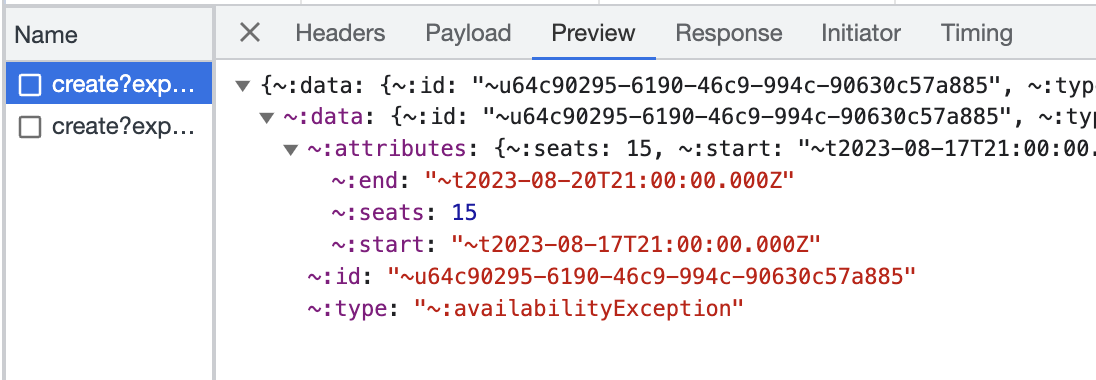
Finally, we want to show the number of seats for exceptions as well. We
will do that in the same WeeklyCalendar.js file that we modified for
the default plan.
The component here we want to modify is AvailableExceptionsInfo. It
uses the same marketplace text key
EditListingAvailabilityPanel.WeeklyCalendar.available as the
PlanEntry component.
// Component that renders all the ExceptionEntry components that allow availability (seats > 0)
const AvailableExceptionsInfo = ({
availableExceptions,
useFullDays,
isDaily,
timeZone,
onDeleteAvailabilityException,
}) => {
const hasAvailableExceptions = availableExceptions.length > 0;
return hasAvailableExceptions ? (
<>
<Heading as="h6" rootClassName={css.exceptionsSubtitle}>
<FormattedMessage id="EditListingAvailabilityPanel.WeeklyCalendar.available" />
</Heading>
{availableExceptions.map((exception) => {
return (
<ExceptionEntry
key={exception.id.uuid}
exception={exception}
timeZone={timeZone}
useFullDays={useFullDays}
isDaily={isDaily}
onDeleteAvailabilityException={
onDeleteAvailabilityException
}
/>
);
})}
</>
) : null;
};Since we are modifying the daily bookings, each day can only have a
single exception. Therefore, we can determine the number of seats based
on the first item in the availableExceptions array. Then, we just need
to pass the value of seats to FormattedMessage.
// Component that renders all the ExceptionEntry components that allow availability (seats > 0)
const AvailableExceptionsInfo = ({
availableExceptions,
useFullDays,
isDaily,
timeZone,
onDeleteAvailabilityException,
}) => {
const hasAvailableExceptions = availableExceptions.length > 0;
+ const seats = hasAvailableExceptions ? availableExceptions[0].attributes.seats : null;
return hasAvailableExceptions ? (
<>
<Heading as="h6" rootClassName={css.exceptionsSubtitle}>
- <FormattedMessage id="EditListingAvailabilityPanel.WeeklyCalendar.available" />
+ <FormattedMessage
+ id="EditListingAvailabilityPanel.WeeklyCalendar.available"
+ values={{ seats }}
/>
</Heading>Now, you can see the number of seats on each exception, as well.
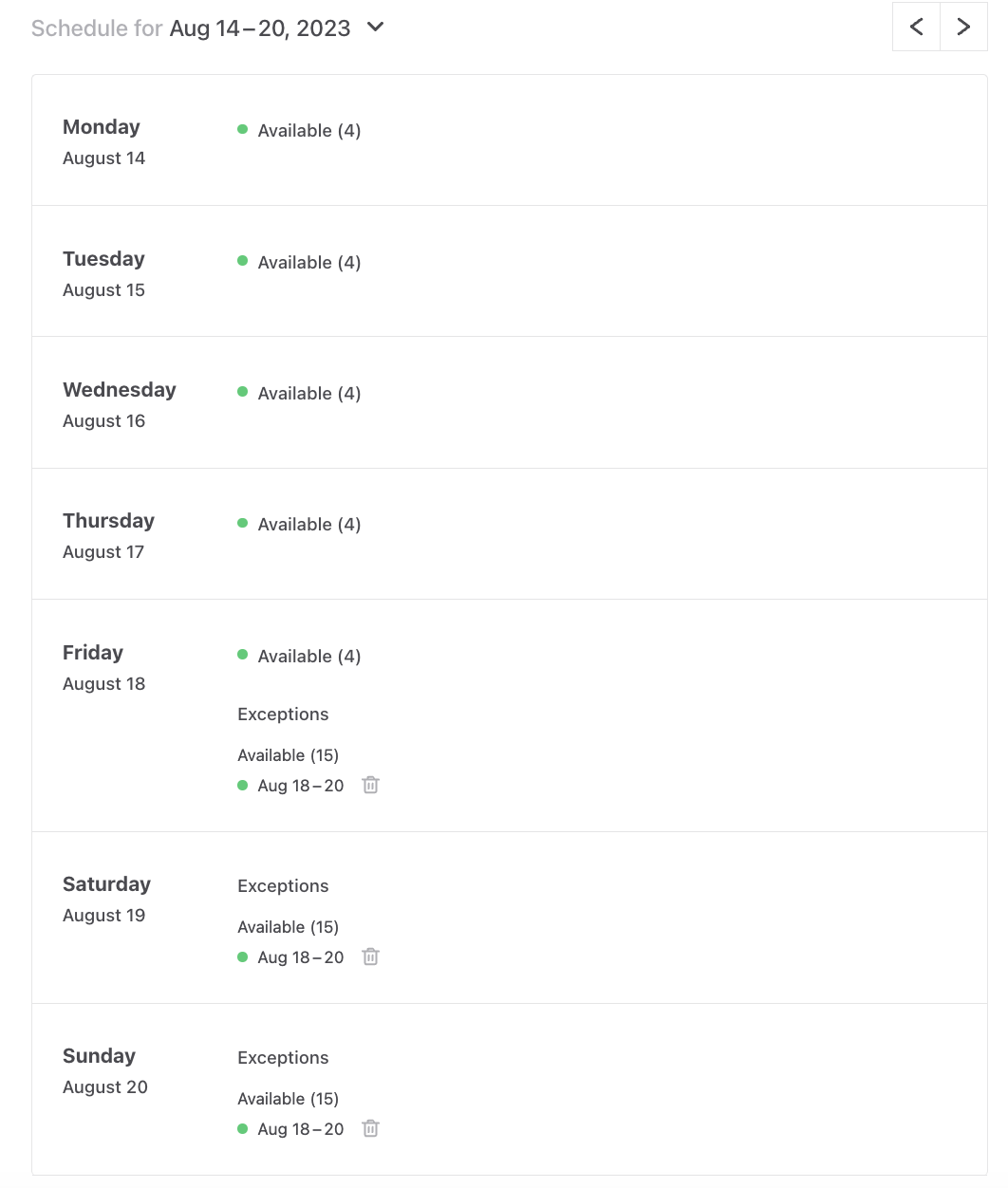
Update listing booking flow to allow bookings with seats
We now have a listing with multiple seats available for booking! Next, we need to add the logic for customers to book more than one seat in that listing.
Show seats input in order form
First, let’s add the necessary seats inputs to the listing page booking form.
First, we need to add a few helper functions to the BookingDatesForm.
These functions help us determine the lowest number of seats available
in the specified time range. For instance, if a customer wants to book
Monday through Sunday, and Friday already has a booking, we can only
allow the customer to book as many seats as are available for Friday.
Let’s add the following import and two functions after the existing
imports in BookingDatesForm.js:
import { generateMonths } from '../../../util/generators';
/**
* Return an array of timeslots for the months between start date and end date
* @param {*} monthlyTimeSlots
* @param {*} startDate
* @param {*} endDate
* @param {*} timeZone
* @returns
*/
const pickBookingMonthTimeSlots = (
monthlyTimeSlots,
startDate,
endDate,
timeZone
) => {
// The generateMonths generator returns the first day of each month that is spanned
// by the time range between start date and end date.
const monthsInRange = generateMonths(startDate, endDate, timeZone);
return monthsInRange.reduce((timeSlots, firstOfMonth) => {
return [
...timeSlots,
...pickMonthlyTimeSlots(monthlyTimeSlots, firstOfMonth, timeZone),
];
}, []);
};
// Get the time slot for a booking duration that has the least seats
const getMinSeatsTimeSlot = (
monthlyTimeSlots,
timeZone,
startDate,
endDate
) => {
const timeSlots = pickBookingMonthTimeSlots(
monthlyTimeSlots,
startDate,
endDate,
timeZone
);
// Determine the timeslots that fall between start date and end date
const bookingTimeslots = timeSlots.filter((ts) => {
const { start, end } = ts.attributes;
return (
// booking start date falls within time slot
(start < startDate && end > startDate) ||
// whole time slot is within booking period
(start >= startDate && end <= endDate) ||
// booking end date falls within time slot
(start < endDate && end > endDate)
);
});
// Return the timeslot with the least seats in the booking period
return bookingTimeslots.reduce((minSeats, ts) => {
if (!minSeats?.seats) {
return ts.attributes;
}
return ts.attributes.seats < minSeats.seats
? ts.attributes
: minSeats;
}, {});
};Next, we will modify the handleFormSpyChange function to include
seats. You can replace the existing handleFormSpyChange function with
the following code:
const handleFormSpyChange =
(
listingId,
isOwnListing,
fetchLineItemsInProgress,
onFetchTransactionLineItems
) =>
(formValues) => {
const { seats, bookingDates } = formValues.values;
const { startDate, endDate } = bookingDates ? bookingDates : {};
if (startDate && endDate && !fetchLineItemsInProgress) {
onFetchTransactionLineItems({
orderData: {
bookingStart: startDate,
bookingEnd: endDate,
seats: parseInt(seats, 10),
},
listingId,
isOwnListing,
});
}
};We first get seats from the form values, and then include the value in
orderData.
Then, we will add a function inside the form that retrieves the
available seats. To do that, we will first need to get formApi from
props:
render={fieldRenderProps => {
const {
endDatePlaceholder,
startDatePlaceholder,
formId,
+ form: formApi,
handleSubmit,
intl,
lineItemUnitType,
values,
monthlyTimeSlots,
lineItems,
fetchLineItemsError,
onFetchTimeSlots,
} = fieldRenderProps;
...Next, add the function itself, before the return statement of the form:
const getSeatsArray = () => {
const formState = formApi.getState();
const { bookingDates } = formState.values;
if (!bookingDates) {
return null;
}
const minSeatsTimeSlot = getMinSeatsTimeSlot(
monthlyTimeSlots,
timeZone,
bookingDates.startDate,
bookingDates.endDate
);
// Return an array of the seat options a customer
// can pick for the time range
return Array(minSeatsTimeSlot.seats)
.fill()
.map((_, i) => i + 1);
};Finally, pass props for seatsArray and seatsLabel to
FieldDateRangeInput.
<FieldDateRangeInput
className={css.bookingDates}
...
disabled={fetchLineItemsInProgress}
onClose={event =>
setCurrentMonth(getStartOf(event?.startDate ?? startOfToday, 'month', timeZone))
}
+ seatsArray={getSeatsArray()}
+ seatsLabel={intl.formatMessage({ id: 'BookingDatesForm.seatsTitle' })}
/>Now, we will add the corresponding handling to FieldDateRangeInput.
First, add FieldSelect to the import from components folder:
import { FieldSelect, ValidationError } from '../../components';Next, add the seatsArray and seatsLabel props to the render function
destructuring:
render() {
/* eslint-disable no-unused-vars */
const {
className,
...
onFocusedInputChange,
+ seatsArray,
+ seatsLabel,
...rest
} = this.props;We only want to show the seats selection if the seatsArray has been
calculated and it has more than one item. The template uses this same
logic for products – quantity selection is only shown for items with 2
or more stock available. So, let’s add a conditional component for the
input.
const seatsSelectionMaybe =
seatsArray?.length > 1 ? (
<FieldSelect name="seats" id="seats" label={seatsLabel}>
{seatsArray.map((s) => (
<option value={s} key={s}>
{s}
</option>
))}
</FieldSelect>
) : null;Then, add the seat selector after the validation error in the returned component
return (
<div className={classes}>
{label}
<DateRangeInput {...inputProps} />
<ValidationError className={errorClasses} fieldMeta={meta} />
+ {seatsSelectionMaybe}
</div>
);Now, we can see the seat selector in the order panel when both start and end dates have been selected:
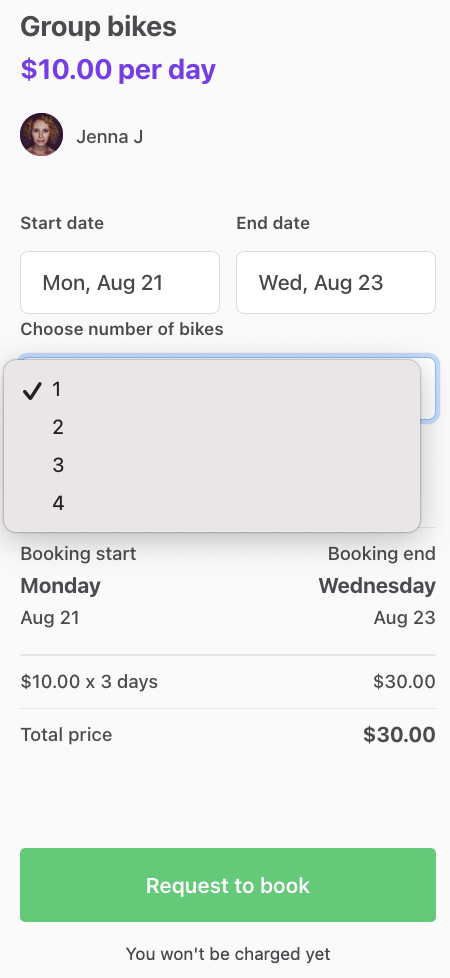
Add seat selection to hourly bookings
Click here to see how to add seat selection to hourly bookings
For hourly bookings, you will need to modify BookingTimeForm and
FieldDateAndTimeInput instead of BookingDatesForm.
The seatsArray variable can be calculated in the
FieldDateAndTimeInput component using the existing selectedTimeSlot
variable. In other words, no need to use the getMinSeatsTimeSlot
helper described above.
const seatsArray =
Array(selectedTimeSlot?.attributes.seats)
.fill()
.map((_, i) => i + 1) || null;
const seatsSelectionMaybe =
seatsArray?.length > 1 ? (
<FieldSelect name="seats" id="seats" label={seatsLabel}>
{seatsArray.map((s) => (
<option value={s} key={s}>
{s}
</option>
))}
</FieldSelect>
) : null;Add seatsSelectionMaybe towards the very end of the returned form:
</FieldSelect>
</div>
</div>
+ {seatsSelectionMaybe}
</div>In BookingTimeForm, you will need to modify handleOnChange to pass
seats from formValues.values to orderData.
handleOnChange(formValues) {
- const { bookingStartTime, bookingEndTime } = formValues.values;
+ const { bookingStartTime, bookingEndTime, seats } = formValues.values;
const startDate = bookingStartTime ? timestampToDate(bookingStartTime) : null;
const endDate = bookingEndTime ? timestampToDate(bookingEndTime) : null;
const listingId = this.props.listingId;
const isOwnListing = this.props.isOwnListing;
// We expect values bookingStartTime and bookingEndTime to be strings
// which is the default case when the value has been selected through the form
const isSameTime = bookingStartTime === bookingEndTime;
if (bookingStartTime && bookingEndTime && !isSameTime && !this.props.fetchLineItemsInProgress) {
this.props.onFetchTransactionLineItems({
- orderData: { bookingStart: startDate, bookingEnd: endDate },
+ orderData: { bookingStart: startDate, bookingEnd: endDate, seats: parseInt(seats, 10) },
listingId,
isOwnListing,
});
}
}In addition, handle seatsLabel similarly to how it is handled above.
If you now select more than one bike for this rental, the price
calculation will still only show the price for one bike. Since we are
already passing the seats value to the onFetchTransactionLineItems
function, our next step is to handle the correct number of seats in the
line item calculation.
Calculate price with seats
To calculate the booking price with the correct number of seats, we need
to modify the line item calculation in server/api-util/lineItems.js.
We also need to modify LineItemBasePriceMaybe.js in the
OrderBreakdown component to show the line items correctly.
We will start with handling the line item calculation server-side, in
lineItems.js.
The lineItems.js file already has several helper functions for
calculating the quantity for different types or line items – days,
nights, hours, and items.
In this guide, we are adding seats for daily bookings, which by default
is managed with the helper function getDateRangeQuantityAndLineItems.
However, we will keep using this function to handle the default case of
a single seat per booking, so we don’t want to modify it. Instead, we
will create a similar function for handling bookings with seats.
Add this new function below getDateRangeQuantityAndLineItems.
/**
* Calculate units based on days or nights between given bookingDates. Returns units and seats.
*
* @param {*} orderData should contain booking dates and seats
* @param {*} code should be either 'line-item/day' or 'line-item/night'
*/
const getDateRangeUnitsSeatsLineItems = (orderData, code) => {
const { bookingStart, bookingEnd, seats } = orderData;
const units =
bookingStart && bookingEnd
? calculateQuantityFromDates(bookingStart, bookingEnd, code)
: null;
return { units, seats, extraLineItems: [] };
};Line item calculation for hourly bookings
Click here to see how to handle line items for hourly bookings
If you are working with hourly bookings, you will need to make a
parallel function for getHourQuantityAndLineItems instead, and add it
to unitType: hour handling.
/**
* Get quantity for arbitrary units and seats for time-based bookings.
*
* @param {*} orderData should contain quantity
*/
const getHourUnitsSeatsAndLineItems = (orderData) => {
const { bookingStart, bookingEnd, seats } = orderData || {};
const units =
bookingStart && bookingEnd
? calculateQuantityFromHours(bookingStart, bookingEnd)
: null;
return { units, seats, extraLineItems: [] };
};We want to use this new function whenever orderData has seats
defined. We do that when defining the quantityAndExtraLineItems
constant, which is also where other similar helper functions are used.
// Here "extra line-items" means line-items that are tied to unit type
// E.g. by default, "shipping-fee" is tied to 'item' aka buying products.
const quantityAndExtraLineItems =
unitType === 'item'
? getItemQuantityAndLineItems(orderData, publicData, currency)
: unitType === 'hour'
? getHourQuantityAndLineItems(orderData)
+ : ['day', 'night'].includes(unitType) && !!orderData.seats
+ ? getDateRangeUnitsSeatsLineItems(orderData, code)
: ['day', 'night'].includes(unitType)
? getDateRangeQuantityAndLineItems(orderData, code)
: {};In Sharetribe, line items need to have either
- a percentage,
- a quantity, or
- both units and seats.
For this reason, we use quantity to denote the number of days when seats are not defined, and units to denote the number of days when seats are defined.
Because we are now handling both quantity and units, we will include
units in our error handling, and then determine which option to use in
the line item.
- const { quantity, extraLineItems } = quantityAndExtraLineItems;
+ const { quantity, units, seats, extraLineItems } = quantityAndExtraLineItems;
// Throw error if there is no quantity information given
- if (!quantity) {
+ if (!quantity && !(units && seats)) {
const message = `Error: transition should contain quantity information:
- stockReservationQuantity, quantity, or bookingStart & bookingEnd (if "line-item/day" or "line-item/night" is used)`;
+ stockReservationQuantity, quantity, units & seats, or bookingStart & bookingEnd (if "line-item/day" or "line-item/night" is used)`;
const error = new Error(message);
error.status = 400;
error.statusText = message;
error.data = {};
throw error;
}
+ // A booking line item can have either quantity, or units and seats. Add the
+ // correct values depending on whether units and seats exist.
+ const quantityOrSeats = !!units && !!seats ? { units, seats } : { quantity };Finally, we replace quantity in the order line item with
quantityOrSeats.
const order = {
code,
unitPrice,
- quantity,
+ ...quantityOrSeats,
includeFor: ['customer', 'provider'],
};Now we have a line item that may have either quantity or units. This
means that we need to modify our line item display component in the
template, since by default it only handles quantity in line items.
By default, LineItemBasePriceMaybe.js has a fairly simple quantity
handling. We will add units handling to this same statement.
/** Replace this **/
const quantity = unitPurchase ? unitPurchase.quantity.toString() : null;
/** with this **/
const quantity = unitPurchase?.units
? unitPurchase.units.toString()
: unitPurchase?.quantity
? unitPurchase.quantity.toString()
: null;We also want to show different messages whenever the order has seats
defined. We will therefore set the FormattedMessage component into a
variable, so we can conditionally use the version that is appropriate.
+ const message = unitPurchase?.seats > 1
+ ? (<FormattedMessage id={`${translationKey}Seats`} values={{ unitPrice, quantity, seats: unitPurchase.seats }} />)
+ : (<FormattedMessage id={translationKey} values={{ unitPrice, quantity }} />)
return quantity && total ? (
<div className={css.lineItem}>
<span className={css.itemLabel}>
- <FormattedMessage id={translationKey} values={{ unitPrice, quantity }} />
+ {message}
</span>
<span className={css.itemValue}>{total}</span>
</div>Now, when we select seats for our booking, we can see the selected seats both calculated and displayed correctly in the breakdown.
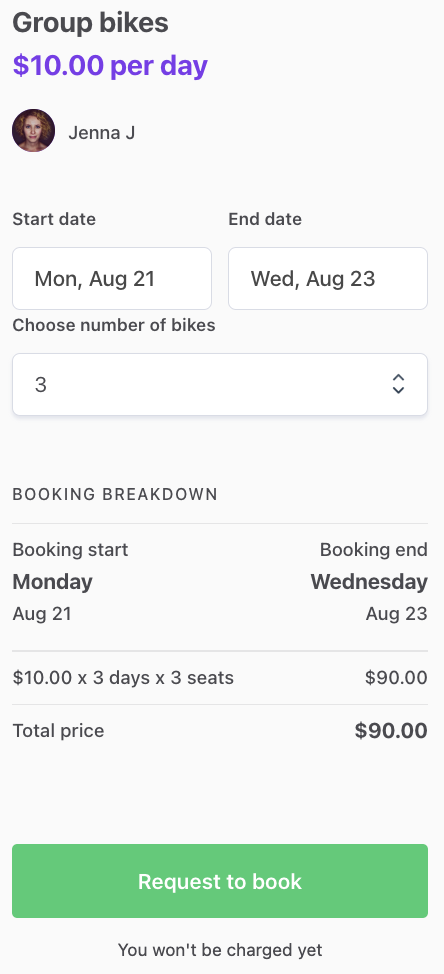
Allow bookings with multiple seats
Finally, we want to include the seats value in the actual booking as
well. Now, if we click on “Request to book”, the CheckoutPage does not
yet recognise any seats for the booking.
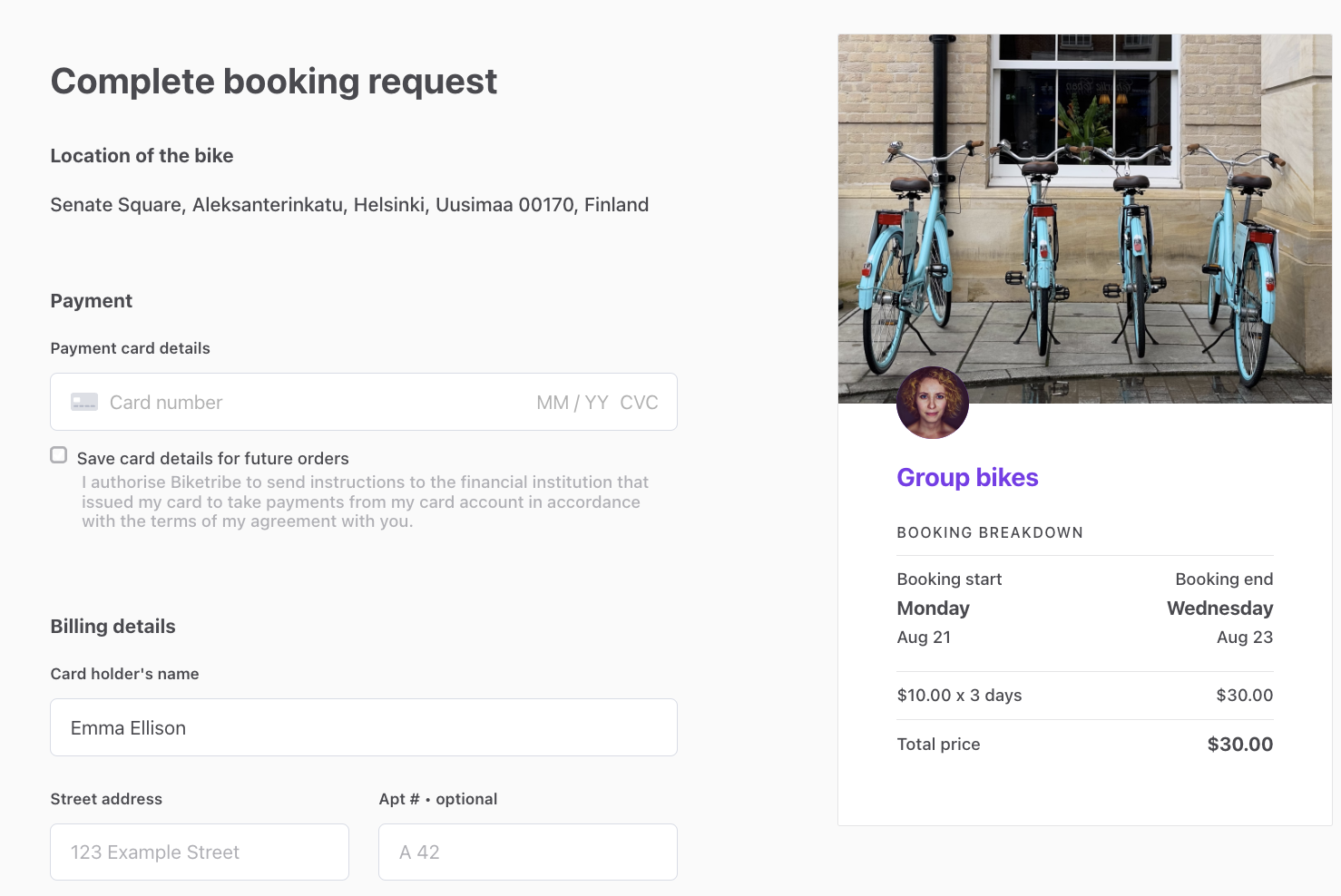
For this, we need to make changes to ListingPage and CheckoutPage. We
will start with modifying the ListingPage.shared.js file to pass the
seats value to CheckoutPage.
Since the template has two listing page components, the functions used
in both components are in ListingPage.shared.js. One of those shared
functions is handleSubmit, which passes the order information to
CheckoutPage. This is the function we will modify.
In this function (and indeed, in this section) we will add seats
handling that parallels the default quantity handling for purchase
items. Both seats and quantity may or may not be present in the
values coming in from the order panel.
First, let’s parse the raw seats value from the values parameter:
const {
bookingDates,
bookingStartTime,
bookingEndTime,
bookingStartDate, // not relevant (omit)
bookingEndDate, // not relevant (omit)
quantity: quantityRaw,
+ seats: seatsRaw,
deliveryMethod,
...otherOrderData
} = values;Then, we will check whether the value of seats is a number, and include
it in the orderData attribute of initialValues sent to
CheckoutPage.
const quantity = Number.parseInt(quantityRaw, 10);
const quantityMaybe = Number.isInteger(quantity) ? { quantity } : {};
+ const seats = Number.parseInt(seatsRaw, 10);
+ const seatsMaybe = Number.isInteger(seats) ? { seats } : {};
const deliveryMethodMaybe = deliveryMethod ? { deliveryMethod } : {};
const initialValues = {
listing,
orderData: {
...bookingMaybe,
...quantityMaybe,
+ ...seatsMaybe,
...deliveryMethodMaybe,
...otherOrderData,
},
confirmPaymentError: null,
};The next step is to pass seats from orderData to Redux actions on the
CheckoutPage. Since we are dealing with payments, we will make the
changes in the CheckoutPageWithPayment.js component.
In this component, the data we passed as orderData is available under
pageData.
CheckoutPageWithPayment makes two Redux calls using order parameters
parsed from pageData:
- fetching speculated transaction immediately when the customer lands on the page, and
- initiating order when the customer has filled out the necessary information
In both of those contexts, the order parameters are created using the
getOrderParams function, so that is where we will add seats
handling. Similarly to ListingPage.shared.js, we will handle seats
the same way we already handle quantity.
const getOrderParams = (pageData, shippingDetails, optionalPaymentParams, config) => {
const quantity = pageData.orderData?.quantity;
const quantityMaybe = quantity ? { quantity } : {};
+ const seats = pageData.orderData?.seats;
+ const seatsMaybe = seats ? { seats } : {};
const deliveryMethod = pageData.orderData?.deliveryMethod;
const deliveryMethodMaybe = deliveryMethod ? { deliveryMethod } : {};
...
// These are the order parameters for the first payment-related transition
// which is either initiate-transition or initiate-transition-after-enquiry
const orderParams = {
listingId: pageData?.listing?.id,
...deliveryMethodMaybe,
...quantityMaybe,
+ ...seatsMaybe,
...bookingDatesMaybe(pageData.orderData?.bookingDates),
...protectedDataMaybe,
...optionalPaymentParams,
};
return orderParams;
};When we pass seats as a part of orderParams to the Redux actions,
the default handling passes them onwards to the line item calculation we
modified earlier.
Now, you can make a booking with multiple seats!
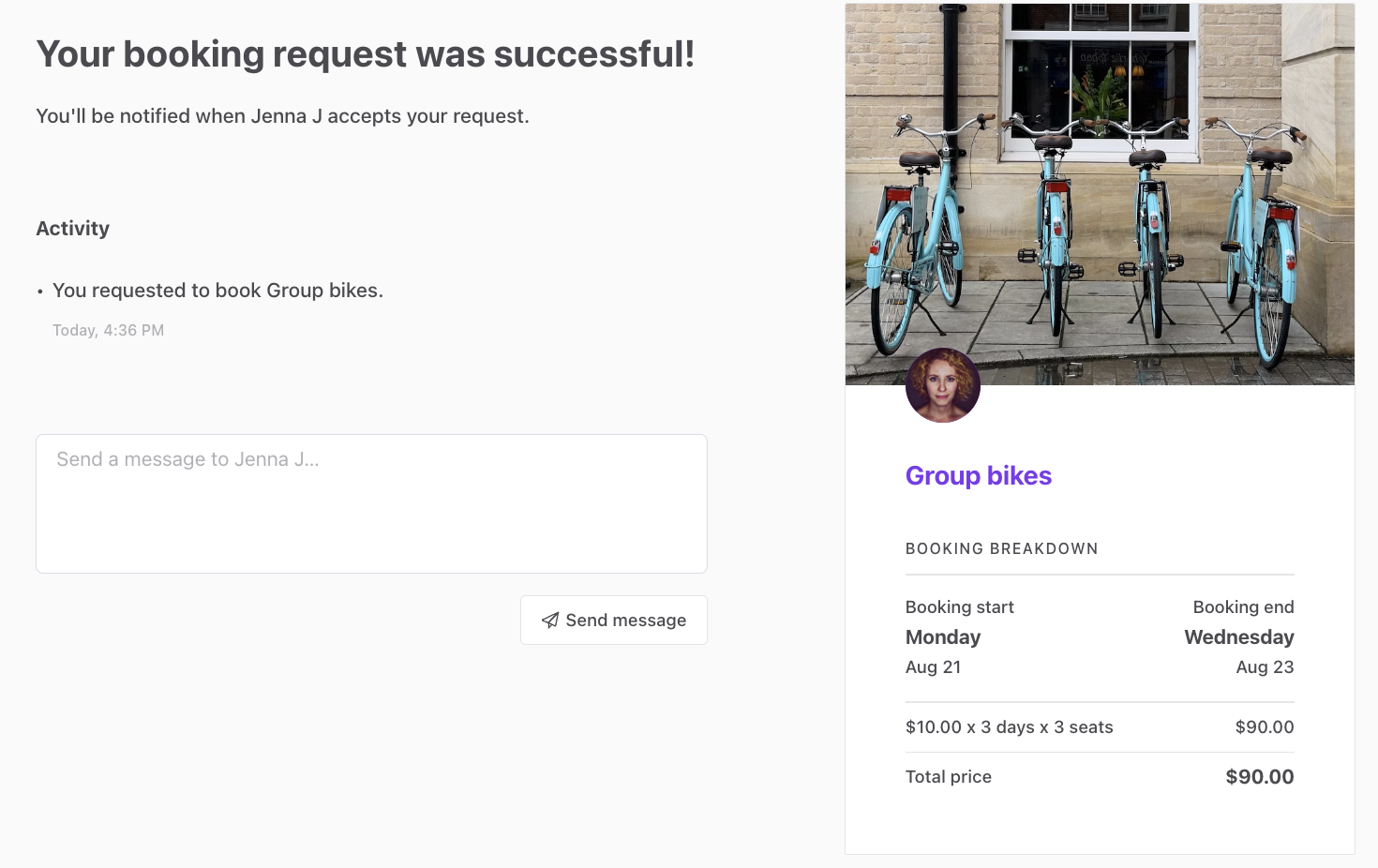
Recap
In this guide, you made the following changes:
- Allow adding seats to a listing
- Update default availability plan handling in
EditListingAvailabilityPanel.jsandAvailabilityPlanEntries.js - Update availability exception handling in
EditListingAvailabilityExceptionForm.js - Update seats display in
WeeklyCalendar.js
- Update default availability plan handling in
- Show seats selection in the order panel
- Add seats handling to
FieldDateRangeInput.js - Add logic to determine minimum seats per a time range in
BookingDatesForm.js
- Add seats handling to
- Calculate line items with seats
- Add units and seats handling to
lineItems.js - Add units and seats handling to
LineItemBasePriceMaybe.js
- Add units and seats handling to
- Allow bookings with multiple seats
- Add seats handling to
ListingPage.shared.js,CheckoutPage.jsandCheckoutPage.duck.js
- Add seats handling to